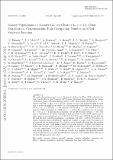| dc.contributor.author | McDonald, Michael | |
| dc.date.accessioned | 2019-06-18T20:33:26Z | |
| dc.date.available | 2019-06-18T20:33:26Z | |
| dc.date.issued | 2017-01 | |
| dc.date.submitted | 2016-04 | |
| dc.identifier.issn | 0035-8711 | |
| dc.identifier.issn | 1365-2966 | |
| dc.identifier.uri | https://hdl.handle.net/1721.1/121353 | |
| dc.description.abstract | We study the galaxy populations in 74 Sunyaev–Zeldovich effect selected clusters from the South Pole Telescope survey, which have been imaged in the science verification phase of the Dark Energy Survey. The sample extends up to z ∼ 1.1 with 4 × 10 14 M ≤ M 200 ≤ 3 × 10 15 M. Using the band containing the 4000 Å break and its redward neighbour, we study the colour–magnitude distributions of cluster galaxies to ∼m ∗ + 2, finding that: (1)The intrinsic rest frame g − r colour width of the red sequence (RS) population is ∼0.03 out to z ∼ 0.85 with a preference for an increase to ∼0.07 at z = 1, and (2) the prominence of the RS declines beyond z ∼ 0.6. The spatial distribution of cluster galaxies is well described by the NFW profile out to 4R 200 with a concentration of c g = 3.59 +−002018 , 5.37 +−002724 and 1.38 +−002119 for the full, the RS and the blue non-RS populations, respectively, but with ∼40 per cent to 55 per cent cluster to cluster variation and no statistically significant redshift or mass trends. The number of galaxies within the virial region N 200 exhibits a mass trend indicating that the number of galaxies per unit total mass is lower in the most massive clusters, and shows no significant redshift trend. The RS fraction within R 200 is (68 ± 3) per cent at z = 0.46, varies from ∼55 per cent at z = 1 to ∼80 per cent at z = 0.1 and exhibits intrinsic variation among | en_US |
| dc.language.iso | en | |
| dc.publisher | Oxford University Press (OUP) | en_US |
| dc.relation.isversionof | http://dx.doi.org/10.1093/MNRAS/STX175 | en_US |
| dc.rights | Creative Commons Attribution-Noncommercial-Share Alike | en_US |
| dc.rights.uri | http://creativecommons.org/licenses/by-nc-sa/4.0/ | en_US |
| dc.source | arXiv | en_US |
| dc.title | Galaxy Populations in Massive Galaxy Clusters to z = 1.1: Color Distribution, Concentration, Halo Occupation Number and Red Sequence Fraction | en_US |
| dc.type | Article | en_US |
| dc.identifier.citation | Hennig, C. et al. "Galaxy Populations in Massive Galaxy Clusters to z = 1.1: Color Distribution, Concentration, Halo Occupation Number and Red Sequence Fraction." Monthly Notices of the Royal Astronomical Society 467, 4 (January 2017): 4015–4035 © 2017 The Authors | en_US |
| dc.contributor.department | MIT Kavli Institute for Astrophysics and Space Research | en_US |
| dc.relation.journal | Monthly Notices of the Royal Astronomical Society | en_US |
| dc.eprint.version | Original manuscript | en_US |
| dc.type.uri | http://purl.org/eprint/type/JournalArticle | en_US |
| eprint.status | http://purl.org/eprint/status/NonPeerReviewed | en_US |
| dc.date.updated | 2019-06-17T20:42:24Z | |
| dspace.date.submission | 2019-06-17T20:42:25Z | |
| mit.journal.volume | 467 | en_US |
| mit.journal.issue | 4 | en_US |
